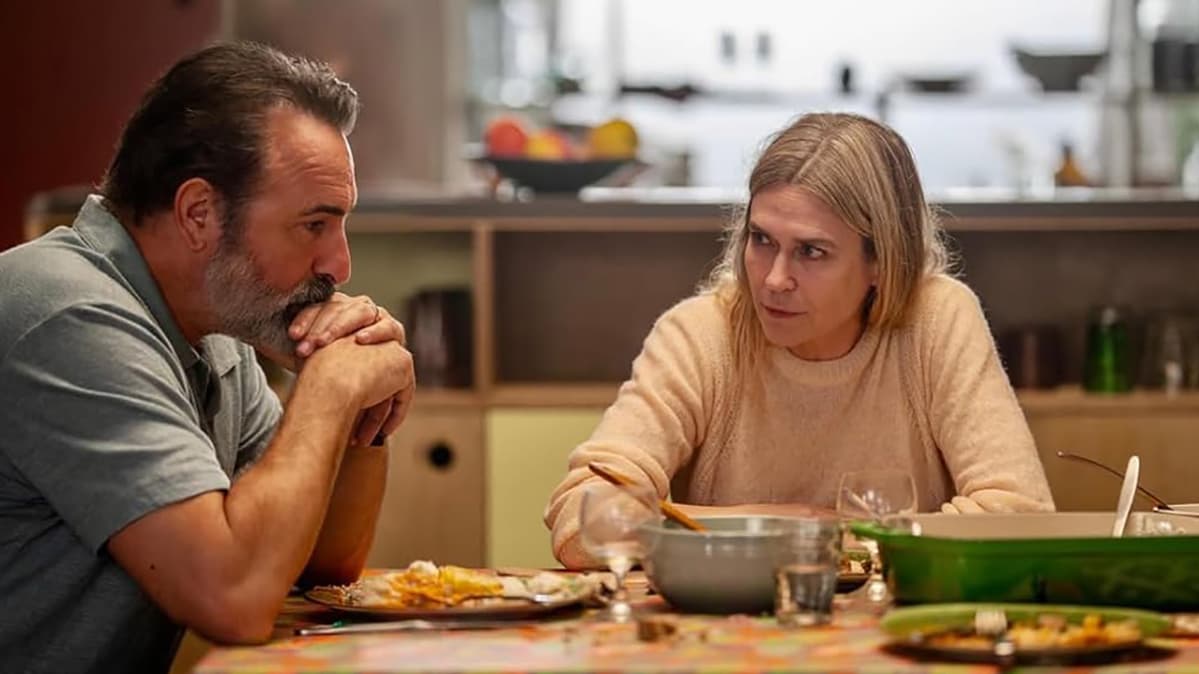In Jan Kounen’s work, the image opens to the Earth, to the sky, this “force of the universe that we ignore,” says the voice-over. Then the hero Jean Dujardin appears on the screen, tall and powerful, defying a whirlwind alone in the sea. By Jack Arnold, this Hollywood science fiction classic, released in 1957, does not begin with the afterlife, but with a couple embracing on board a boat, in the middle of the waves, watched by the fog when Madame goes to fetch the gentleman’s beer.
Simple difference in form or a real desire not to copy his elder and place his work in another place, close to the pure forces of the cosmos? On the occasion of the theatrical release of Jan Kounen’s modern version, with Jean Dujardin and Marie-Josée Croze, on October 22, the BFMTV.com editorial staff presents a point-by-point comparison of these two variations of The shrinking manadapted from the novel of the same name by Richard Matheson, published in 1956.
Pretty faithful scenario
If the two films do not begin under exactly the same auspices, the script of The shrinking man The 2025 version faithfully follows Jack Arnold’s. Each time, it is a man, Paul – Jean Dujardin for Kounen, and Grant Williams for Jack Arnold -, contaminated, who shrinks little by little, until he becomes dust, or almost.
Until then, he and his wife led a quiet life in a luxurious house: modern and with sea views in the first, more vintage and suburban in the second. In the contemporary version, he also has a young daughter, exaggerates marital happiness, dances, prepares dinner, and refuses to undergo medical examinations when his shrinkage shows the tip of his nose.
But in both films, Paul gradually isolates himself and lets himself be carried away by his sad destiny. However, at Arnold’s house he decides to talk to the press and tell his sad story. He also leaves his house, enters a fair and meets a dwarf, who for a time gives him the feeling of being “normal.” He is also waiting for treatment to cure him. Hope lurks.
Then each time, halfway through, the hero, reduced to eking out a living in a dollhouse, is attacked by a cat. Despite himself, he locks himself in his basement and disappears from the surface. Paul, alone, fights for his survival, facing insects and a spider. The remake also adds a scene in a fish tank or another in the grooves of a table.
Completely depoliticized
But Jan Kounen’s film lacks substance and even flatly depoliticizes the inaugural version. The French filmmaker, originally from the Netherlands, explains Paul’s shrinkage by a mysterious contamination of the cosmos, while, for Arnold, it is explicitly linked to the effect of insecticides and nuclear radiation. The pamphlet against norms and standardization is also eliminated.
Above all, as an existentialist morality, The shrinking man The 1957 version seems to want to show us to what extent life has meaning (“I understood the mystery of the infinite, my reflection was [jusqu’alors] He stopped in the limited dimension of man. He had abused nature. It was the concept of man who wanted existence to have an end. All this vast and majestic creation had to have meaning (…). Yes, even though it was small, it made sense,” proclaims the protagonist’s voice-over at the end of the film).
In Kounen the reading is completely different. More moralistic, more punitive and more nihilistic too. It tells us that life has no meaning and that humans are mere dust, always dissatisfied in an individualistic world. “You just have to look at the sky to feel very small, we are tiny and we call it ‘a life’, we tell ourselves stories,” the hoarse and peremptory voice-over, played by Jean Dujardin, immediately launches.
Then, throughout the film, she emerges and spouts empty, vain phrases straight out of a wellness manual? – that: “We regret the previous time, the one we wanted to change”, “Whatever we do, our lives bear little resemblance to the stories we tell ourselves, our lives decide for us”, “Even when we have everything to be happy, we still get agitated”, “The only solution to not suffer is to act”. And the highlight of the show: “This will be my life, a battle lost beforehand.”
Of course, the special effects of the Universal remake, with a budget of 21 million euros according to the CNC, the seventh most expensive French film in 2025, are much more careful and effective than those of the 1957 version. They are more credible, they favor the play of scale, they amplify the action and horror scenes. But they hardly compensate for, or even contribute to creating, an overly slick and bland image.
Source: BFM TV


